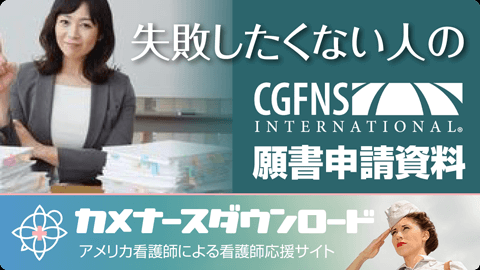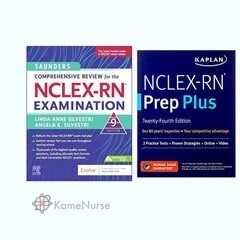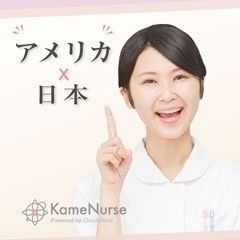看護師が患者さんに投与する色々な輸液点滴の基礎知識 #12
輸液とは、体液や栄養の補給を目的として,大量の液を静脈内または皮下などに注入すること。医師や看護師は一般的に経静脈的すなわち血管より輸液を「点滴」する医療行為を毎日のように行ってます。
この点滴の液には、たくさんの種類があります。アメリカ看護師試験前に講師より、その種類は、目的に合わせて使い分けられる、「等張性:Isotonic」「低張性:Hypotonic」「コロイド:Colloid」の3分類に分けて記憶するよう指導をされました。
そこで今日は輸液分類まとめです。この後の脱水や体液の評価、電解質のまとめにも輸液分類が関わるのでしっかり自分自身で理解することが試験合格につながると思います!
静脈内輸液の種類と特徴メモ
Types of Intravenous Solutions
等張性:Isotonic 輸液
特徴メモ
- 体液と同じ浸透圧 (Same osmolality as body fluids=273 mOsm/L)
- 細胞外液量を増やす目的で使用される( Increase extracellular fluid volume)
- 血液は細胞外液(extracellular fluid)
- 血管内や組織間に水分・電解質を補給できる輸液
- 乳酸リンゲル液は、熱傷患者さんによく使用することがある
- 乳酸リンゲル液は、カリウムを含むので腎不全の患者さんには投与すべきではない(Lactated Ringer's solutions, contains potassium and should not be administered to a client with renal failure)
- 乳酸リンゲル液にはKが4 mEg/L, Naが130 mEg/L, Caが3 mEg/L, Clが109 mEg/L, lactate 28 mEg/L 入ってる
- 下記の等張性液の中でカリウム(K)が入ってるのはラクトリンゲルのみ
等張性輸液の種類:Isotonic
0.9% saline (NS)
5% dextrose in water( D5W)
5% dextrose in 0.225% saline (D5W1/4NS)
Lactated Ringer's solutions
低張性輸液:Hypotonic
特徴メモ
- 体液より電解質濃度が低い輸液
- Movement of water from cells = 154 mOsm/L (1/2NS)
低張性輸液の種類:Hypotonic
0.45% saline (1/2NS)
0.225% saline (1/4NS)
0.33% saline (1/3NS)
特徴メモ
- 細胞内の水を血管に引き込みたい時に使用する
- Movement of water from cell into the extracellular fluid by osmosis = over 500 mOsm/L
低張性輸液の種類:Hypotonic
3% saline (3%NS)
5% saline (5%NS)
10% dextrose in water (D10W)
5% dextrose in 0.9% saline (D5W/NS)
5% dextrose in 0.45% saline (D5W/1/2NS)
5% dextrose in lactated Ringer's solutions
コロイド輸液:Colloid
特徴メモ
- 血漿増量剤は出血や重度の血液量減少などの血管容積・循環血液量を補い増やす
- Plasma expanders, the vascular volume tepidly, such as in hemorrhage or sever hypovolemia
コロイド輸液の種類:Colloid
Dextran
Albumin
輸液点滴に関する問題
看護師が患者さんの巡回に行ったところ非経口栄養バッグ(点滴バック)が空になっていました。患者さん専用の調合されたバッグが看護ユニット到着するまで、どの輸液を対処的に使用するべきか問われています。
A nurse is making initial rounds at the beginning of the shift and notes that parenteral nutrition bag of an assigned client is empty. Which of the following solution readily available on the nursing unit hang until another PN solution is mixed and delivered to the nursing unit?
- 5% dextrose in water( D5W)
- 10% dextrose in water( D5W)
- 5% dextrose in Ringer's lactated
- 5% dextrose in 0.9% sodium chloride
Answer: 2
対処的に使用する輸液は、患者さんの低血糖を防ぐためにデキストロース(糖)が高い輸液を選ぶのが正解です。
出典/引用:SAUNDERS
このページ内で、ナースが知っておきたい輸液点滴に使われている単位と略語
| mOsm/L | ミリオスモル |
| mEg/L | ミリエクイバレント、メック |
| NS:Normal Saline solution | 生理食塩水 |
| % | パーセント |
| NS:Normal Saline solution | 生理食塩水 |
| PPN:Peripheral parenteral nutrition | 末梢静脈栄養 |
| PPN:Peripheral parenteral nutrition | 末梢静脈栄養 |
| mL | ミリリットル |
| TPN:Total parenteral nutrition | 完全静脈栄養・中心静脈栄養 |
| gtt:drops:Latin "guttae" | 点滴の滴下 |
| 60 gtts/ mL | 1mLを60滴で滴下 |
ナースが知っておきたい輸液点滴の基礎
- マクロ・ドリップ用点滴ルート(Macre drip)の点滴菅は10-20 gtts/ mL
- マイクロ・ドリップ用点滴ルート(Micro drip)の点滴菅は60 gtts/ mL
例えば 50 mlなどの少量点滴ボトルを1時間くらいかけてゆっくり点滴する時や小児の点滴に使用する点滴菅 - 患者さんに空気塞栓症の疑いがある時の体位は、左側臥位で頭を足よりも低い体位にする
Patient position in case of suspected air embolism. On the left side, head lower than feet. - 末梢静脈栄養 PPN:Peripheral parenteral nutritionをウイニングする時は徐々に量を減らすこと。急に0 mLに」すると低血糖(Hypoglycemia)になる。もしPNNのバックが空になっていて、つなぎで点滴する時は10% dextrose in waterで!糖が入ってないから0.9% nomal salineに交換はダメ!
- 点滴中の患者さんに看護師が一番に注意必要なことは、感染による体温上昇(Infection)、2番は循環血液量過多症による体重の増加(Hyper volemia)
中心静脈栄養 TPN:Total parenteral nutrition
- 中心静脈栄養 TPN:Total parenteral nutritionは10%グルコース以上の高カロリー輸液を投与したい時に留置する
- 中心静脈栄養 TPN留置の患者さんは尿糖、アセトン、尿比重を8時間ごとにチェックすることが望ましいとされてる
- 中心静脈栄養 TPNのバック、チューブ交換や抜去の時、患者さんに「Valsalva mannenver :Take a deep breath, hold it, and bear down」をしてもらう。右鎖骨下静脈に留置されている時は、頭は左に向けてもらう。
(TPN),中心静脈栄養と(PPN)末梢静脈栄養に関するに関する問題
(TPN),中心静脈栄養と(PPN)末梢静脈栄養に関する記述のうち、記述が正しいか問われています。
The nurse plans care for a client receiving total parenteral nutrition (TPN), understanding that which of the following statements regarding TPN and Peripheral parenteral nutrition(PPN) is true?
- TPN is usually indicated for clients needing long-term nutrition support, whereas PPN is for short-term support.
- TPN is used to deliver isotonic or mildly hypertonic solutions, whereas PPN is used to deliver highly hypertonic solutions.
- PPN is indicated for clients needing more than 2000cal, whereas TPN is indicated for clients needing less than 2000 cal.
- PPN is indicated for clients who are NPO(nothing by mouth), whereas TPN is indicated for clients who need to supplement oral intake.
Answer: 1
1以外の記述は (TPN),中心静脈栄養と(PPN)末梢静脈栄養が逆になっている。
出典/引用:SAUNDERS



























